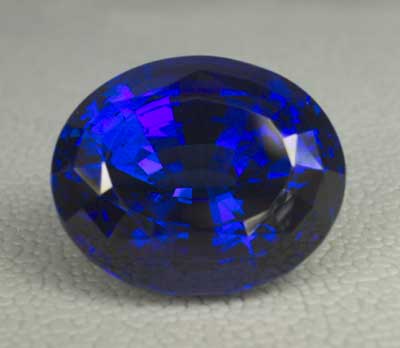|

By Richard
W. Hughes
Introduction/Name
Tanzanite
is the name given to the rich blue-violet variety of the epidote-group
mineral, zoisite. The gem was first discovered in Tanzania in 1967
and was named after its country of its origin, Tanzania, by the famous
New York jeweler, Louis Comfort Tiffany.
Color
Tanzanite
has what many would consider the finest blue hue in the world of gemstones,
a color which often leaves even the finest sapphires lacking. The gem
is strongly trichroic.
 A
chromium-colored green tanzanite
is also found in Tanzania. A
chromium-colored green tanzanite
is also found in Tanzania.
Lighting
Tanzanite
is extremely light sensitive, with incandescent lighting tending to
shift its color to the violet side. The best pieces show an intense
blue under any light.
Clarity
In
terms of clarity, tanzanite does occur in reasonably clean crystals.
Thus when buying, the standard is eye-clean stones.
Cut
In
the market, tanzanites are found in a variety of shapes and cutting
styles. Ovals and cushions are the most common, but rounds are also
seen, as are other shapes, including emerald cuts, trillions, etc.
Cabochon-cut tanzanites are not often seen.
 |
| Magnificent untreated tanzanite crystal.
Crystal: Bill Larson collection; Photo: Jeff Scovil |
|
Prices
Tanzanite
prices probably fluctuate more than any other gem, largely due irregular
production at the mines. For extremely fine stones of less than 50
cts., prices sometimes top $1000/ct. at retail.
Stone
Sizes
Tanzanites sometimes occur in extremely large
sizes, with faceted gems of hundreds of carats in existence. The
most popular sizes for jewelry use are those below 20 cts.
Sources
The
only locality for tanzanite is Merelani in Tanzania.
Enhancements
Virtually
all gem tanzanite of a blue color has been heat-treated to enhance
the color.
Imitations
Tanzanite
has never been synthesized, but a number of imitations exist. The most
common is blue-violet glass. A synthetic fosterite has also been used
as an imitation.
|
|
| This
suite of tanzanites shows the typical range of colors possible.
The ideal would be the center stone, which is not too light or
dark. Photo: Wimon Manorotkul;
Gem: Pala International |
|
Properties
of Tanzanite
| |
Tanzanite
(a variety of zoisite) |
| Composition |
Ca2Al2(SiO4)3(OH) |
| Hardness
(Mohs) |
6
to 7 |
| Specific
Gravity |
3.35
(+ 0.10, -0.25) |
| Refractive
Index |
1.691–1.700
(0.008–0.013); Doubly refractive, biaxial positive |
| Crystal
System |
Orthorhombic |
| Colors |
Blue,
violet, green, brown |
| Pleochroism |
Strongly
trichroic |
| Dispersion |
0.021 |
| Cleavage |
Perfect
in one direction |
| Phenomena |
Cat’s
eyes are known. Many tanzanites display a color shift from blue
in daylight to violet in incandescent light |
| Handling |
Ultrasonic: Unsafe;
never clean tanzanite with ultrasonic cleaners
Steamer: Not
safe
The best way to care for tanzanite is to clean it with warm, soapy
water
Acids: Attacked
by hydrochloric and
hydrofluoric acids
Heat: Fuses
under jeweler’s
torch; sudden temperature
changes may cause cracking |
| Enhancements |
Virtually
all tanzanite is heat treated (approx. 500°C), which converts
the brown pleochroic color to blue |
| Synthetic
available? |
No |
Further Reading
The Collector Gem Buying Guides
In addition to the above, please visit the Learning
Vault at Palagems.com for many additional articles on gems, minerals and mining.
|




